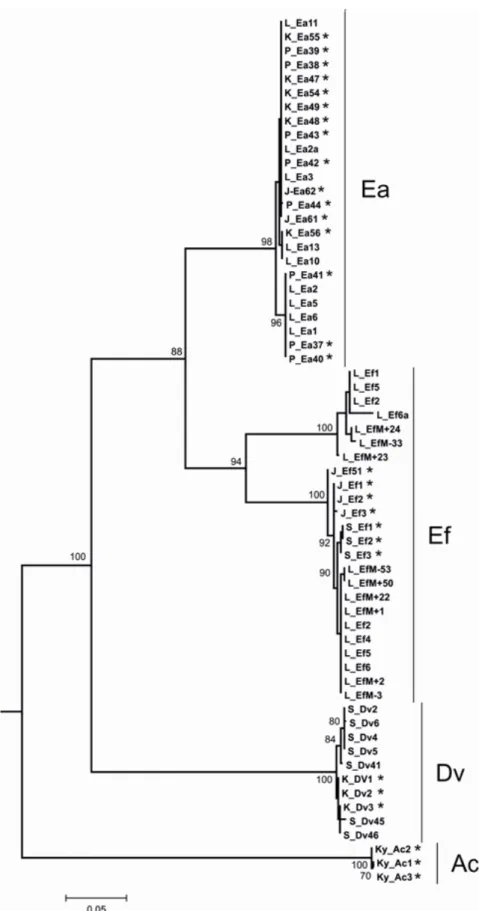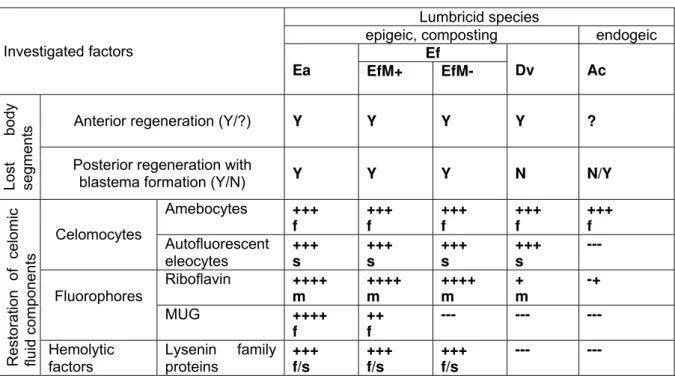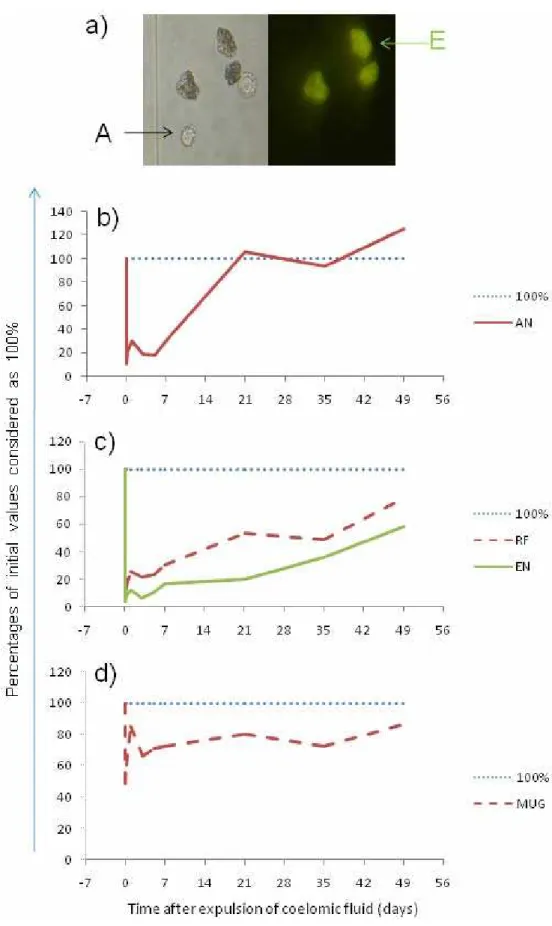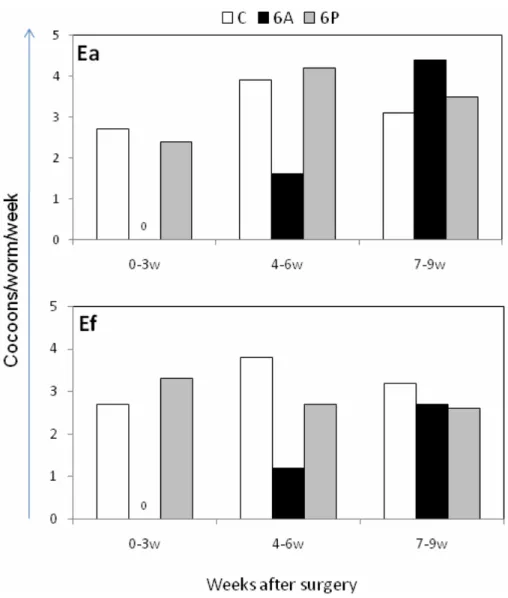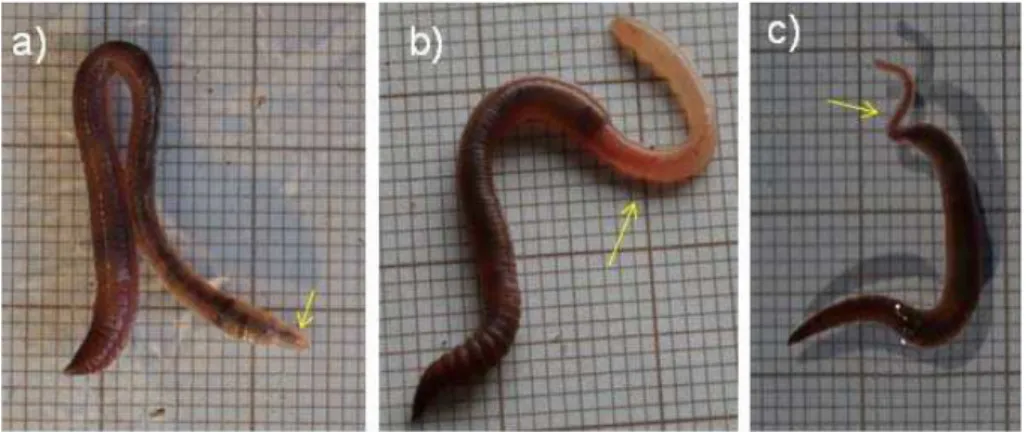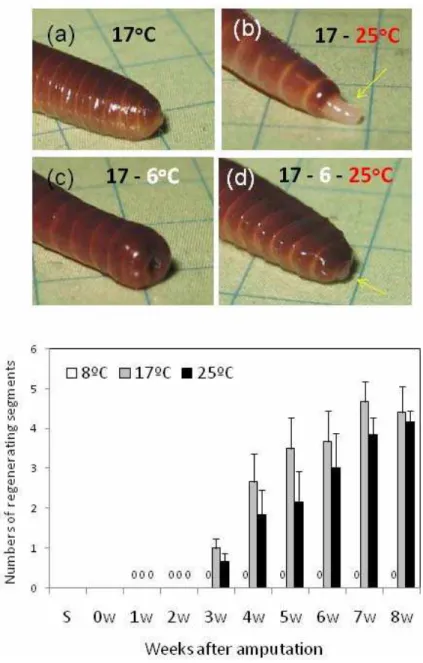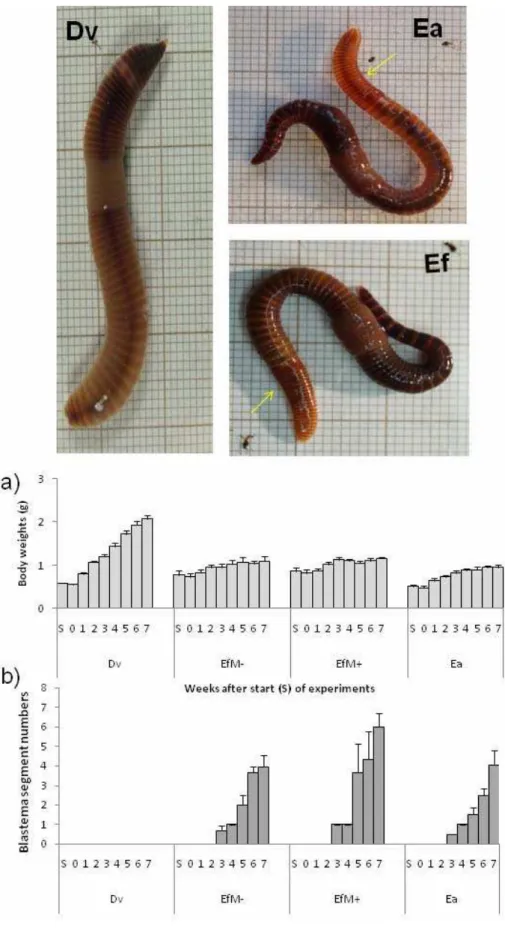ISJ 13: 315-325, 2016
ISSN 1824-307X
MINIREVIEW
Unexpected results and open questions from experiments on regeneration in
lumbricid worms
B Plytycz
1, J Bigaj
1, A Falniowski
2,AJ Morgan
31
Department of Evolutionary Immunology, Institute of Zoology, Jagiellonian University, Krakow, Poland 2Department of Malacology, Institute of Zoology, Jagiellonian University, Krakow, Poland
3
Cardiff School of Biosciences, Main Building, Cardiff University, Cardiff CF10 3US, Wales, UK
Accepted September 20, 2016
Abstract
Lumbricid worms are commonly subjected to noxious stimuli leading to expulsion of celomic fluid
or to loss of body segments; therefore regeneration of lost segments and restoration of the depleted
cellular and soluble components of celomic fluid are of fundamental importance for these animals.
Series of experiments was performed on regeneration abilities in well-defined epigeic species
Eisenia
andrei
,
E. fetida
and
Dendrobaena veneta
, and endogeic
Aporrectodea caliginosa.
Efficient
regeneration of the lost anterior or posterior segments was consistently observed in
Eisenia
sp. In a
sharp contrast,
D. veneta
regenerated amputated anterior segments or extirpated suprapharyngeal
ganglia (‘brains’) while regeneration of posterior segments was never recorded so far in this species.
In
A. caliginosa
a loss of posterior segments was followed either by compensatory body growth or by
formation of regeneration blastema. In all species regeneration was cold-inhibited while was resistant
to cadmium soil pollution. The efficiency of regenerative processes in
E. andrei
and
E. fetida
might be
connected with quality and quantity of some components of their celomic fluid; lysenin is unique for
these species and riboflavin is much more abundant in
Eisenia sp
. than in other lumbricids
investigated so far.
Key Words: earthworms; autotomy; regeneration; celomocytes; amebocytes; riboflavin
Introduction
Lumbricid worms are commonly subjected to sub-lethal predator attacks leading to loss of body segments. Body segments may be lost also by self-amputation called autotomy (Zoran, 2010). Earthworms may be subjected to mechanical/chemical stimuli inducing spasmic body movements connected with expulsion of celomic fluid containing the celomocytes and soluble factors crucial for immunity (Bilej et al., 2011; Ottaviani, 2011). Therefore regeneration of lost segments or restorations of the extruded cellular and soluble components of celomic fluid are of fundamental importance for these animals. Segmental body organization coupled with easy noninvasive celomic fluid retrieval make them attractive models for qualitative and quantitative interspecies comparisons of regeneration capabilities (Bely et al., 2006; Bely and Sikes, 2010; Zoran, 2010).
___________________________________________________________________________
Corresponding author:
Barbara Plytycz
Department of Evolutionary Immunology Institute of Zoology
Jagiellonian University
Gronostajowa 9, 30-387 Krakow, Poland
315
E-mail: barbara.plytycz@uj.edu.plWe have investigated the effects of some endogenous and exogenous factors on the restoration of certain depleted components of celomic fluid as well as the regeneration of the lost body segments in three epigeic lumbricid species, Dendrobaena veneta (Dv), Eisenia andrei (Ea), and E. fetida (Ef) delimitated by barcoding of the mitochondrial cytochrome C oxidase subunit I (COI) gene and supplemented in some specimens by MUG/MUG-like fluorophore (4-methylumbelliferyl β -D-glucuronide) characteristics (Fig. 1), by the methods described previously (Rorat et al., 2014). We have examined two distinct cohorts of E. fetida: one that expresses (EfM+) and one that does not express (EfM-) a MUG-like fluorophore. These three composting species are easy to maintain and culture under laboratory conditions. In addition, we investigated a fourth species, the endogeic Aporrectodea caliginosa (Ac), which normally inhabits mineralized soil and is not so easy to maintain.
316
317
Table 1 Celomocyte restoration characteristics and regeneration of anterior and posterior segments in four lumbricid species: Eisenia andrei (Ea); E. fetida (EfM+, EfM-); Dendrobaena veneta (Dv); A. caliginosa (Ac)
Lumbricid species
epigeic, composting
endogeic
Ef
Investigated factors
Ea
EfM+ EfM-
Dv
Ac
Anterior regeneration (Y/?)
Y
Y
Y
Y
?
Lost bod
y
seg
m
ent
s
Posterior regeneration with
blastema formation (Y/N)
Y
Y
Y
N
N/Y
Amebocytes
+++
f
+++
f
+++
f
+++
f
+++
f
Celomocytes
Autofluorescent
eleocytes
+++
s
+++
s
+++
s
+++
s
---
Riboflavin
++++
m
++++
m
++++
m
+
m
-+
Fluorophores
MUG
++++
f
++
f
--- --- ---
Re
storation of
cel
o
mic
fluid com
pon
ents
Hemolytic
factors
Lysenin family
proteins
+++
f/s
+++
f/s
+++
f/s
--- ---
Presence/absence (+/-) of investigated factors and their restoration/regeneration abilities/rates considered as present/lacking (Y/N), and fast (f), moderate (m) or slow (s). Note that restoration of cellular and soluble components of celomic fluid and segment regeneration in Eisenia spp. are relatively resistant to soil pollution, and regenerative processes in all species are inhibited at low ambient temperatures (for detail see text).
induced self-amputation (autotomy) (see Galuszka et al., 2015; Kocinski et al., 2016); anterior brain-containing segments were either amputated or only cerebral ganglia were surgically extirpated (Okrzesik et al., 2013; Molnar et al., 2015).
Here we review the main results from the published and unpublished experiments. A summary of our findings is presented in Table 1.
Restoration of some components of celomic fluid after experimental expulsion
The investigated composting species, Ea, Ef, and Dv, belong to lumbricids possessing two main populations of cells floating in celomic fluid, i.e., the immunocompetent amebocytes and autofluorescent chloragocyte-derived granular eleocytes (Fig. 2a), the latter containing various nutritive substances, e.g., riboflavin (see Plytycz and Morgan, 2011). In contrast, Ac is an example of lumbricid species possessing in celomic fluid almost exclusively the amebocytes. Riboflavin is stored in high or moderate quantities in eleocytes of Eisenia sp. and Dv, respectively (Rorat et al., 2014; Santocki et al., 2014, 2016a), but is also present in the attached chloragocytes residing on the celomic surface of the alimentary canal of all investigated lumbricid species (Mazur et al., 2013).
Controlled expulsion of celomic fluid through dorsal pores of the earthworms may be induced by various irritants like 5 % ethanol (Cooper et al.,
1995), ultrasounds (Hendawi et al., 2004) or mild electric current (Roch, 1979), the latter procedure modified and used in present studies (see Gałuszka et al., 2015; Kociński et al., 2016). Drastic depletion of morphotic elements is followed by several week-lasting recovery process, originally described in Lumbricus terrestris devoid of eleocytes (Eyambe et al., 1991). In Ac, another lumbricid species devoid of chloragocyte-derived eleocytes, restoration of amebocytes was even faster in Cd-polluted soil than in the clean soil; in this species restoration was temperature-dependent, being slower at 6 oC than at 25 oC (Galuszka et al., 2015).
Fig. 2 Some components of celomic fluid of Eisenia andrei. a) group of 5 celomocytes in fluorescent microscope (left: bright field; right: blue light), among them 2 amebocytes (A) and 3 autofluorescent eleocytes (E); b-d) Restoration of the components of celomic fluid after experimental depletion induced at time 0 by electrostimulation (4.5V, 30 sec), expressed as percentages of initial values (C) considered as 100 % (modified according to Santocki et al., 2016b): b) numbers of amebocytes (AN); c) numbers of eleocytes (EN) and riboflavin (RF) content; d) content of MUG fluorophore.
Fig. 3 Effects of anterior or posterior segments amputation on reproduction of composting worms. Cocoons production in Eisenia andrei (Ea) and E. fetida (Ef) either intact control worms (C) or those subjected at time 0 to surgical amputation of either 6 anterior segments (6A) or 6 posterior segments (6P), 8 worms in each group. Note that in groups (6A) of both species cocoons were absent during the first 3 weeks and their production started between 4th and 6th week after surgery, while in both species cocoon production was unaffected in worms with amputated posterior segments (6P). Numbers of cocoons in boxes containing 8 worms from either (C), (6A), or (6P) groups of Ea or Ef, calculated per worm and per week.
Restoration of components of celomic fluid was more efficient in juvenile than in adult worms (Santocki et al., 2016a). Contrary to our working hypothesis, the kinetics of restoration of amebocytes, eleocytes and riboflavin content in juvenile Ea was not affected in worms maintained in soil polluted with cadmium at concentrations inhibiting worm growths and maturation (Takacs et al., 2016, submitted). Also in adult Ea worms, similar exposure to cadmium polluted soil inhibited cocoon production with negligible effects on restoration of the depleted components of celomic fluid (Rorat et al., in preparation). Putatively metallothioneins are responsible for protection of cadmium exposed celomocytes (Homa et al., 2015; Rorat et al., in preparation).
The MUG fluorophore is a molecular marker of E. andrei (Albani et al., 2003), but MUG-like fluorophore is also present in some specimens of E. fetida (EfM+) (Rorat et al., 2014; Santocki et al., 2016a; Swiderska et al., 2016). The initial contents of MUG/MUG-like fluorophores in celomic fluid of Ea was less depleted after electrostimulation and restored relatively quickly (Fig. 2d); much faster than restoration of riboflavin (compare Figs 2c, d) (Santocki et al., 2016b; Swiderska et al., 2016). The biological function and cellular source/s of MUG/MUG-like molecules is presently unknown. Are MUG-positive E. fetida earthworms the interspecific hybrids between Ea and EfM-? Experiments aimed in answering this are in progress.
Fig. 4 Various forms of regeneration of amputated or autotomized posterior segments in Aporrectodea caliginosa (Ac): a) delayed formation of blastema, 3 months after amputation; b) very unusual non-pigmented blastema several months after autotomy; c) worm amputated and kept in cold for 3 weeks without rudiments of blastema, and then formation of tiny blastema within 2 weeks after transfer to room temperature.
Lysenin, i.e., hemolytic sphingomyelin-binding pore-forming protein (Roch, 1979; Cooper et al., 2002 De Colibus et al., 2012; Bokori-Brown et al., 2016) and lysenin-related proteins were detected in all investigated specimens of Eisenia sp., both Ea and Ef (the latter both EfM+ and EfM-) but not in D. veneta (Swiderska et al., 2016). After experimental expulsion of celomic fluid, content of lysenin was restored faster in cellular fraction containing lysenin-storing eleocytes than in soluble fraction of celomic fluid (Swiderska et al., 2016). However, lysenin is still a puzzling component of defense system of Eisenia sp., as the presence of its main target, sphingomyelin, seems to be restricted mainly to vertebrate cells membranes (Kobayashi et al., 2000; Shakor et al., 2003). In contrast, both the Eisenia earthworms (McLaughlin 1971) and the main invaders of their celomic cavity, i.e., bacteria, fungi, and small invertebrates, are devoid of sphingomyelin in the cell membranes (Hori and Sugita, 1993), thus in the earthworms its anti-microbial function may be performed by sphingomyelin-independent mechanisms (Cooper et al., 2002; Bruhn et al., 2006), e.g., due to its opsonizing properties (Hayashi et al., 2013). Putatively another function of lysenin in Eisenia sp. earthworms might be induction of avoidance behavior of the potential vertebrate predators (like birds, hedgehogs, or moles) after irritating their mucosa with lysenin-containing celomic fluid. Hypothetically, we cannot exclude that lysenin might be involved in wound healing and/or regenerative processes.
Regeneration of extirpated brains or amputated anterior brain-containing segments
Surgical extirpation of suprapharyngeal ’cerebral’ ganglia (‘brains’) or amputation of brain containing anterior segments of Dv caused an immediate inhibition of reproduction that was recovered in tandem with restoration of brain integrity, including active neurosecretory cells (Okrzesik et al., 2013; Molnar et al., 2015).
Restoration of reproduction, thus also regeneration of vital brain centers, was markedly more efficient in worms with intact immune system than in those subjected to electrostimulation-induced loss of amebocytes, eleocytes, and soluble components of immune system. And vice versa, restoration of components of celomic fluid was faster in intact worms than in their counterparts engaged in regenerating their extirpated brains (Molnar et al., 2015). Such experimental model is unquestionably amenable to further detailed examinations of interactions between earthworm neuroendocrine and immune systems (Plytycz and Morgan, 2015).
Since a reappearance of temporarily inhibited cocoon production is a convenient biomarker of regeneration of the brain morphology and functions, the present studies included monitoring reproductive activity of unmanipulated (control) adult specimens of Ea and Ef, the latter either EfM+ and EfM-, and their counterparts with surgically amputated of either six anterior (brain-containing) or six posterior segments. As in Dv, cocoon production was hardly affected by amputation of posterior segments, while was completely inhibited for several weeks in all brainless worms, and then was gradually restored (Fig. 3). Thus, amputation of anterior segments or brain extirpation/regeneration is an attractive model for studies of neurohormonal-immune interactions in the composting species. However, to date we observe that such invasive treatment causes mortality in Ac worms.
Species-specific reactions to loss of posterior segments
In the present studies either surgical amputation of posterior segments was performed or their controlled self-amputation (autotomy) was induced. Autotomy of body segments followed by their regeneration is an adaptive strategy of lumbricid worms as anti-predator strategy and the disposal of encapsulated parasites or toxic products (Lesiuk and Drewers, 1999). Experimental controlled autotomy of posterior segments may be
Fig. 5 Effects of temperature on regeneration of amputated posterior segments in E.andrei from Kluczbork (a) or Pecs (b). Top: Photos of blastema formation (yellow arrows) 17 days after amputation of 10 posterior segments in worms a) kept at 17 oC; b) transferred after amputation to 25 oC; c) transferred after amputation to 6 oC; d) transferred after amputation for 10 days to 6 oC and then to 25 oC (photos by Majos P). Note the lack of blastema in worms kept in cold. Bottom: numbers of regenerating segments (SN) in earthworms adapted to either 8 oC, 17
o
C, or 25 oC, estimated at the start of experiments (S) on week 0 (0w) and then during 8 subsequent weeks after surgery; means ± SE (n = 4 worms per group); 0 - no blastema.
321
induced in worms subjected to multiply electrostimulation. The pulsating direct electric current from a 4.5 V cell phone electric charger was necessary to induce it in E. andrei, while A. caliginosa were more prone for autotomy that was evoked not only by pulsating direct current but also by direct current from battery or immersion in noxious MS-222 solution. Autotomized segments in Ea were quickly replaced by newly formed once, while segment regeneration, if any, was significantly delayed in Ac (Kocinski et al., 2016). Such reproducible models of autotomy may serve for
studies on molecular-genetic mechanisms underpinning autotomy and subsequent regeneration.
Fig. 6 Effects of amputation of posterior segments in Dendrobaena veneta (Dv), Eisenia fetida (Ef, either Ef- or Ef+), and Eisenia andrei (Ea) kept at 23 oC. Bottom part: Changes of a) body weights (BW) and b) numbers of regenerating segments estimated at the start of experiments (S) on week 0 (0w) and then during 7 subsequent weeks after surgical amputation of 10 posterior segments; means ± SE (n = 3 worms per group); 0 - no blastema. Top part: Photos of Dv, Ea, and Ef taken 3 months after amputation of posterior segments at 25th segment after clitellum. Note the lack of regenerating segments in Dv, and their presence in Ea and Ef (yellow arrows).
323
(Galuszka et al., 2015). In one instance we observed a long regeneration non-pigmented ‘tail’ in Ac (Fig. 4b). In several small specimens of Ac amputated and kept for 3 months at 6 oC blastemas were absent but very thin “fragile” blastemas appeared soon after the worm transfer to 20 oC (Fig. 4c).
In E. andrei, amputation of body segments induced blastema formation that was rapid at 17 oC and 25 oC but was completely inhibited at low temperature (8 oC) (Fig. 5, bottom). As exemplified on top of Figure 5, amputation of 10 posterior segments in Ea kept at 17 oC was followed by regeneration blastema formation that was faster in worms transferred to higher temperature (25 oC), while was absent in worms transferred to cold (8
o
C), but that was quickly rescued after worm transfer to 25 oC (Fig. 5, top). At high temperature, blastema formation was unaffected in Ea kept in cadmium polluted soil (Takacs et al., submitted) putatively due to protective role of metallothioneins (Rorat et al., in preparation). Similar cold-inhibition and cadmium resistance of blastema formation was observed in A. caliginosa (Gałuszka et al., 2015).
Unexpectedly, we have so far been unable to observe blastema formation and regenerating posterior segments in D. veneta. Figure 6 (bottom) shows that regeneration of the amputated ten posterior segments was consistently present and similar in Ea and Ef, the latter both Ef+ and Ef-, while was consistently absent in D. veneta. In this experiment initial body weights of worms were similar, but body weight gain was much faster in Dv than in the both Eisenia sp., thus it might be supposed that loss of a few segments only was neglected due to the fast body growth. However, when specimens of Eisenia sp. and D. veneta were amputated at the 25th segment after clitellum, 4 months after surgery regenerated segments were clearly visible in Ea and Ef but not in Dv (Fig. 6, top).
In conclusion, both autotomy and surgical amputation of posterior segments in Ea and Ef are followed by formation of regeneration blastema that is cold-inhibited but efficient at high temperatures. Formation of regeneration blastema is either absent or significantly delayed or modified in Ac, and consistently absent in Dv. In other words, blastema-involved epimorphic type of regeneration is common in Eisenia sp., while D. veneta perform morphallactic type of regeneration. Therefore comparative studies on these closely related and ecophysiologically similar species may serve as convenient models to delineate differences and similarities in the regenerative capabilities at the genetic, molecular and cellular levels (Alvarado and Tsonis 2006).
Summary and concluding remarks
A summary of our main findings is presented in Table 1. Anterior regeneration is present in Eisenia sp. and D. veneta, but head amputation was lethal for Ac investigated so far. Posterior regeneration with blastema formation was consistently present in Eisenia sp., consistently absent in D. veneta, and absent or attenuated in Ac. Among depleted celomic
fluid components, restoration of amebocytes was efficient in all species. Autofluorescent eleocytes were present and restored slowly in Eisenia sp, and D. veneta; Riboflavin content was very high in Eisenia sp. and lower in Dv, but in both species regenerated in a moderate rate. MUG/MUG-like fluorophore was present and restored fast in all Ea and some specimens of Ef (EfM+). Hemolytic proteins of lysenin family are restricted to Eisenia sp.
Why D. veneta, with a very efficient brain regeneration capability has a weak posterior segment blastema formation is an open question. Is this connected with lower riboflavin content in Dv eleocytes relative to the same cell type in Ea and Ef species? What is a source of the abundant riboflavin stores in Eisenia spp.? Is this connected with horizontal gene transfer as suggested earlier (Sulik et al., 2012)?
Evidently, restoration of brain-containing anterior segments is of highest priority for all epigeic earthworms often exposed to predator attacks, but studies on endogeic Ac shall be continued. Loss of posterior segments may be followed by compensatory body growth and/or regeneration blastema formation. Blastema formation is most efficient in Eisenia sp., possessing in celomic cavity huge amounts of riboflavin and lysenin. Participation of riboflavin in regeneration is well documented (Johnson et al., 2012).
Participation of factors derived from celomic cavity of Eisenia sp. in wound healing is extensively investigated (Cooper et al., 2004; Grdisa et al., 2004; Matausijc-Pils et al., 2010). At the place of wounds secreted lysenin with opsonizing properties could cover the damaged endogenous cells and aid the phagocytes to engulf them (Hayashi et al., 2013). Since wound healing consists of parallel processes of regeneration and scar formation (White et al., EOLLS), some celomic factors of Eisenia species (e.g., riboflavin and/or lysenin) may act in favor of regenerative blastema formation. In other lumbricid species some external and/or endogenous factors might be necessary to elicit the latent regeneration abilities (Bely and Sikes, 2010).
Acknowledgements
This work was supported by the National Centre of Science (B/NZ4/01640, K/PBO/000178) and K/ZDS/005405 from the Jagiellonian University. We thanks to students, Gałuszka A, Tengolics A, and Takacs V for participation in studies and taking photos. We gratefully acknowledge the valuable comments and suggestions of Anonymous Reviewers.
References
Albani JR, Demuynck S, Grumiaux F, Leprêtre A. Fluorescence fingerprints of Eisenia fetida and Eisenia andrei. Photochem. Photobiol. 78: 599-602, 2003.
Alvarado AS, Tsonis PA. Bridging the regeneration gap: genetic insights from diverse animal models. Nature Rev. Genetics 7: 873-884, 2006. Bely AE. Distribution of segment regeneration ability
324
persist following recent evolutionary loss in asexual annelids. Proc. Natl. Acad. Sci. USA 26: 1464-1469, 2010.
Bilej M, Prochazkova P, Silerowa M, Joskova R. Earthworm immunity. Adv. Exp. Med. Biol. 708: 66-79, 2011.
Bokori-Brown M, Martin TG, Naylor CE, Basak AK, Titball RW, Savva CG. Cryo-EM structure of lysenin pore elucidates membrane insertion by an aerolysin family protein. Nat. Commun. 7:11293. doi: 10.1038/ncomms11293, 2016. Bruhn H, Winkelmann J, Andersen C, Andra J,
Leippe M. Dissection of mechanisms of cytolytic and antibacterial activity of lysenin, a defence protein of the annelid Eisenia fetida. Dev. Comp. Immunol. 30: 597-606, 2006.
Cooper EL, Hrzenjak TM, Grdisa M. Alternative sources of fibrinolytic, anticoagulative, antimicrobial and anticancer molecules. Int. J. Immunopathol. Pharmacol. 17: 237-244, 2004 Cooper EL, Cossarizza A, Suzuki MM, Salvioli, S.,
Capri M, Quaglino D, et al. Autogenic but not allogenic earthworm effector coelomocytes kill the mammalian tumor target K562. Cell. Immunol. 166: 113-122, 1995.
Cooper EL, Kauschke E, Cossarizza A. Digging for innate immunity since Darwin and Metchnikoff. BioEssays 24: 319-333, 2002.
De Colibus L, Sonnen AF-P, Morris KJ, Siebert CA, Abrusci P, Plitzko J. Structures of lysenin reveal a shared evolutionary origin for pore-forming proteins and its mode of sphingomyelin recognition. Cell 20: 1498-1507, 2012.
Eyambe GS, Goven AJ, Fitzpatrick LC, Venables BJ, Cooper. EL. A noninvasive technique for sequential collection of earthworm (Lumbricus terrestric) leukocytes during subchronic immunotoxicity studies. Lab. Anim. 25: 61-67, 1991.
Gałuszka A, Klimek B, Bigaj J, Plytycz B. Endogeic earthworm Aporrectodea caliginosa as a model species for studies of modulation of regeneration by environmental stressors. Acta Biol. Crac. Zool. 57: 15-23, 2015.
Grdisa M, Popović M, Hrzenjak T. Stimulation of growth factor synthesis in skin wounds using tissue extract (G-90) from the earthworm Eissenia foetida. Cell Biochem. Funct. 22: 373-378, 2004.
Hayashi Y, Miclaus T, Scavenius C, Kwiatkowska K, Sobota A, Engelmann P, et al. Species differences take shape at nanoparticles: protein corona made of the native repertoire assists cellular interaction. Environ. Sci. Technol. 47: 14367-14375, 2013.
Hendawi M. Sauve S, Ashour M, Brousseau P, Fournier M. A new ultrasound protocol for extrusion of coelomocyte cells from the earthworm Eisenia fetida. Ecotoxicol. Environ. Saf. 59: 17-22, 2004.
Homa J, Rorat A, Kruk J, Cocquerelle C, Plytycz B,Vandenbulcke F. Dermal exposure of Eisenia andrei earthworms: Effects of heavy metals on metallothionein and phytochelatin synthase gene expressions in coelomocytes. Environ.Toxicol. Chem. 34: 1397-1404, 2015.
Prog. Lipid Res. 32: 25-45, 1993.
Johnson Retnaraj Samuel SC, Elaiya Raja S, Beryl Vedha Y, Edith Arul Jane A, Amutha K, Dinesh SM, et al. Autofluorescence in BrdU-positive cells and augmentation of regeneration kinetics by riboflavin. Stem Cells Dev. 21: 2071-2083, 2012.
Klimek M, Kruk J, Plytycz B. Restoration of coelomocytes in the earthworm Dendrobaena veneta. Acta Biol. Cracov. Zool. 54: 11-17, 2012. Kobayashi H, Selizawa Y, Aizu M, Umeda M. Lethal
and non-lethal responses of spermatozoa from a wide variety of vertebrates and invertebrates to lysenin, a protein from the coelomic fluid of the earthworm Eisenia foetida. J. Exp. Zool. 286: 533-549, 2000.
Kocinski M, Takacs V, Molnar L, Morgan AJ, Bigaj J, Plytycz B. Experimental induction of autotomy in two potential model lumbricid earthworms Eisenia andrei and Aporrectodea caliginosa. Inv. Surv. J. 13: 11-17, 2016.
Lesiuk NM, Drewers CD. Autotomy reflex in a freshwater olgochaete, Lumbriculus variegates (Clitellata: Lumbriculidae). Hydrobiologia 406: 253-261, 1999.
Matausijć-Pisl M, Cupić H, Kasuba V, Mikecin AM, Grdisa M. Tissue extract from Eisenia foetida as a wound-healing agent. Eur. Rev. Med. Pharmacol. Sci. 14: 177-184, 2010.
Mazur AI, Klimek M, Morgan AJ, Plytycz B. Riboflavin storage in earthworm chloragocytes and chloragocyte-derived eleocytes and its putative role as chemoattractant for immunocompetent cells. Pedobiologia 54S: S37-S42, 2011.
McLaughlin J. Biochemical studies on Eisenia foetida (Savigny, 1926), the brandling worm: I. Tissue lipids and sterols. Comp. Biochem. Physiol. 38B: 147-163, 1971.
Molnar L, Pollak E, Skopek Z, Gutt E, Kruk J, Morgan AJ, et al. Immune system participates in brain regeneration and restoration of reproduction in the earthworm Dendrobaena veneta. Dev. Comp. Immunol. 52: 269-279, 2015.
Okrzesik J, Kachamakowa-Trojanowska N, Jozkowicz A, Morgan AJ, Plytycz B. Reversible inhibition of reproduction during regeneration of cerebral ganglia and celomocytes in the earthworm Dendrobaena veneta. Inv. Surv. J. 10: 151-161, 2013.
Ottaviani E. Immunocyte: the invertebrate counterpart of the vertebrate macrophage. Inv. Surv. J. 8: 1-4, 2011.
Plytycz B, Morgan AJ. Interactions between earthworm neuroendocrine and immune systems. Inv. Surv. J. 12: 176-178, 2015.
Roch, P. Protein analysis of earthworm coelomic fluid: I. Polymorphic system of natural hemolysin of Eisenia fetida andrei. Dev. Comp. Immunol. 3: 599-608, 1979.
325
Rorat A, Vandenbulcke F, Galuszka A, Klimek B, Molnar L, Morgan AJ, et al. Protective role of metallothionein in Eisenia andrei regenerating depleted coelomocytes or lost body segments during temperature-dependent cadmium exposure [in preparation].
Santocki M, Falniowski A, Plytycz B. Restoration of experimentally depleted coelomocytes in juvenile and adult composting earthworms Eisenia andrei, E. fetida and Dendrobaena veneta. Appl. Soil Ecol. 104: 163-173, 2016a.
Santocki M, Klimek M, Kruk J, Płytycz B. Preliminary report on coelomocyte system during ontogeny of the earthworm Dendrobaena veneta. Acta Biol. Crac. Zool. 55/56: 65-71, 2014.
Santocki M, Morgan AJ, Plytycz B. Differential time course of restoration of experimentally depleted coelomocytes and fluorophores in the earthworm Eisenia andrei. Folia Biol. (Krakow) 64: 121-130, 2016b.
Shakor AA, Czuryło EA, Sobota A. Lysenin, a unique sphingomyelin-binding protein. FEBS Lett. 542: 1-6, 2003.
Sulik P, Klimek M, Talik P, Kruk J, Morgan AJ, Plytycz B.Searching for external sources of the riboflavin stored in earthworm eleocytes. Inv. Surv. J. 9: 169-177, 2012.
Swiderska B, Kedracka-Krok S, Panz T, Morgan AJ, Falniowski A, Grzmil P, et al. Lysenin family proteins in earthworm coelomocytes - comparative approach. Dev. Comp. Immunol., DOI: 10.1016/j.dci.2016.08.011, 2016.
Takacs V, Molnar L, Klimek B, Gałuszka A, Morgan AJ, Plytycz B. Exposure of Eisenia andrei (Oligochaeta; Lumbricidea) to cadmium polluted soil inhibits earthworms maturation and reproduction but not restoration of experimentally depleted coelomocytes or regeneration of amputated segments. Folia Biol. (Krakow), 2016 [submitted].
White LM, Roy S, Gordillo GM, Kalliainen LK, Melvin WS, Ellison EC, et al. Wound Healing and Regeneration. Physiology and Maintenance - Vol. I - Encyclopedia of Life Support Systems (EOLSS)
